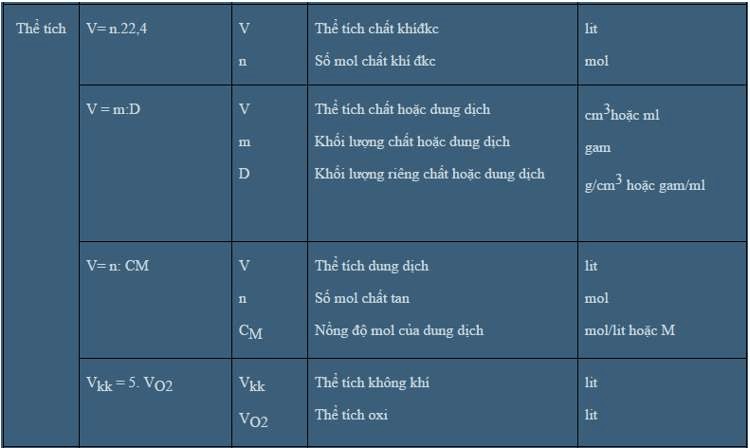What are formulas for calculating chemical volume included in grade 8 curriculum in Vietnam? What is the duration of implementation duration of the grade 8 Natural Science curriculum in Vietnam?
What are formulas for calculating chemical volume included in grade 8 curriculum in Vietnam?
Calculating chemical volume is one of the subjects included in the Grade 8 natural science curriculum. Some Grade 8 chemical volume calculation formulas are as follows:
1. Calculating Volume by Number of Moles
Under standard conditions, the volume of gas equals the number of moles times 22.4. The specific formula for calculating volume by number of moles is as follows:
V = n * 22.4
Where:
V is the volume of gas under standard conditions (l)
n is the number of moles of gas under standard conditions (mol)
2. Calculating Volume by Weight
The volume of a solution or substance is determined by the quotient of the weight of the solution or substance and the density of the solution or substance. The specific formula for calculating volume by weight is as follows:

Where:
V is the volume of the solution or substance (m3)
m is the weight of the solution or substance (kg)
D is the density of the solution or substance (kg/m3)
3. Calculating Volume by Molar Concentration
The volume of a solution is determined by the quotient of the number of moles of solute divided by the molar concentration of that solution. The specific formula for calculating volume by molar concentration is as follows:

Where:
V is the volume of the solution (l)
n is the number of moles of the solute (mol)
CM is the molar concentration of the solution (mol/l)
4. Calculating Air Volume
The volume of air is five times the volume of oxygen. The specific formula is as follows:
Vkk = 5.VO2
Where:
Vkk is the volume of air (l)
VO2 is the volume of oxygen (l)
Summary of chemistry volume calculation formulas for Grade 8


What are formulas for calculating chemical volume included in grade 8 curriculum in Vietnam? What is the duration of implementation duration of the grade 8 Natural Science curriculum in Vietnam? (Image from the Internet)
What is the implementation duration of the Grade 8 natural science curriculum in Vietnam?
According to the General Education Program for the subject of Natural Science issued together with Circular 32/2018/TT-BGDDT:
The duration for each grade is 140 periods per academic year, taught over 35 weeks. The percentage distribution of periods for each topic is presented in the following table:
| Content | Grade 6 | Grade 7 | Grade 8 | Grade 9 |
| Introduction | 5% | 4% | 2% | 2% |
| Matter and its transformations | 15% | 20% | 29% | 31% |
| States of matter | 3% | |||
| Oxygen and air | 2% | |||
| Various materials, fuels, resources, food | 6% | |||
| Solutions; Separating substances from mixtures | 4% | |||
| Atoms. Chemical elements | 6% | |||
| Molecule | 9% | |||
| Overview of the periodic table of chemical elements | 5% | |||
| Chemical reactions | 12% | |||
| Reaction rates and catalysts | 3% | |||
| Acids - Bases - pH - Oxides - Salts; Chemical fertilizers | 14% | |||
| Metals | 8% | |||
| Fundamental differences between non-metals and metals | 4% | |||
| Introduction to organic substances Hydrocarbons and fuel sources |
7% | |||
| Ethyl alcohol, acetic acid; Lipids - Carbohydrates - Proteins - Polymers | 12% | |||
| Living organisms | 38% | 38% | 29% | 25% |
| Cells - Basic units of life | 11% | |||
| Diversity of living organisms | 27% | |||
| Metabolism and energy transformation in organisms | 23% | |||
| Response in organisms | 3% | |||
| Growth and development in organisms | 5% | |||
| Reproduction in organisms; Organism as a unified whole | 7% | |||
| Human biology | 20% | |||
| Environment; Ecosystems | 9% | |||
| Hereditary phenomena | 19% | |||
| Evolution | 6% | |||
| Energy and its transformations | 25% | 28% | 28% | 28% |
| Measurements | 7% | |||
| Force | 11% | 8% | 6% | |
| Density and pressure | 8% | |||
| Energy and life | 7% | 6% | 7% | |
| Sound | 7% | |||
| Light | 6% | 9% | ||
| Electricity | 8% | 7% | ||
| Magnetism | 7% | 5% | ||
| Earth and the sky | 7% | 0% | 2% | 4% |
| Visible movement of the Sun, Moon; Solar System; Milky Way | 7% | |||
| Biosphere and biomes on Earth | 2% | |||
| Resource extraction from the Earth's crust; Brief "Chemistry of the Earth's crust" | 4% | |||
| Periodic evaluation | 10% | 10% | 10% | 10% |
Thus, the implementation duration for the Grade 8 natural science curriculum is 140 periods and conducted over 35 weeks.
What are the materials, specimens, and chemicals used for Grade 8 natural science practice in Vietnam?
Based on the General Education Program for the subject of Natural Science issued together with Circular 32/2018/TT-BGDDT, the materials, specimens, and chemicals used for Grade 8 natural science practice include:
- Instruments for measuring length, area, volume, weight, temperature, time; measuring cars integrated with position sensors, force sensors to survey motion, and friction force;
- Force gauges, rulers, permanent magnet rods, spring scales; frequency generators, tuning forks, oscillographs; tools to create visible light beams, create light and dark areas, mix light colors; flat mirrors, prisms; tools to create field maps, student compasses; permanent magnets, electromagnets;
- Equipment capable of surveying the density of an object and the pressure applied to a surface; simple tools creating levers; tools to create and redistribute electric charges (van de Graaff generator, soft silk, plastic comb...); electric energy measuring kits (joulemeter);
- Kits for surveying light reflection; kits for surveying light refraction; digital scales; handheld pH meters; glassware such as test tubes, flasks, jars, beakers, funnels, basins, pipettes...; chemicals: minimum necessary chemicals for demonstration and practice experiments.
- Specimens of fertilizers; models, molecular assemblies of both hollow and solid forms of alkanes, ethyl alcohol, and acetic acid.
- Microscopic preparations of cells and cell organelles; kits for making dry preserved plant specimens and preserved animal specimens; kits for studying outdoor organisms.
- Kits for practicing bandaging for broken bones, blood pressure monitors, tools for bandaging bleeding wounds. c) Subject Room
- Room space sufficient to arrange equipment, specimens, and furniture for students to perform practice lessons, water taps and sinks, fire prevention and fighting equipment,...
- Fixed equipment: writing boards, sample cabinets, consumables (chemicals, glassware, experimental trays), chemical and experimental tool shelves, poster hangers, stone-tiled practice tables, refrigerators, drying cabinets, dehumidifiers, exhaust fans, protective equipment, tools used according to practice lessons,...
- Electronic and optical devices, audio-visual aids: microscopes, magnifying glasses, binoculars, computers, projectors, screens, TVs,...

